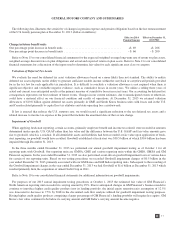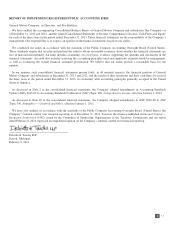General Motors 2013 Annual Report Download - page 48
Download and view the complete annual report
Please find page 48 of the 2013 General Motors annual report below. You can navigate through the pages in the report by either clicking on the pages listed below, or by using the keyword search tool below to find specific information within the annual report.
GENERAL MOTORS COMPANY AND SUBSIDIARIES
The key assumptions utilized in determining the fair value-to-U.S. GAAP differences giving rise to the implied goodwill for the
reporting units requiring a Step 2 analysis are: (1) the determination of our nonperformance risk; (2) interest rates; (3) estimates of our
employee benefit related obligations; and (4) the estimated timing of the utilization of our deferred tax assets, including our
determination whether it is more likely than not that the deferred tax assets will be utilized. For the year ended December 31, 2013
GM Korea’s goodwill assessment was most sensitive to our determination of estimates of our employee benefit related obligations
and GM India’s was most sensitive to the estimated timing of the utilization of our deferred tax assets.
Impairment of Long-Lived Assets
The carrying amount of long-lived assets and finite-lived intangible assets to be held and used in the business are evaluated for
impairment when events and circumstances warrant. If the carrying amount of a long-lived asset group is considered impaired, a loss
is recorded based on the amount by which the carrying amount exceeds the fair value for the long-lived assets or in certain cases, the
asset group to be held and used. Product-specific long-lived asset groups are tested for impairment at the platform or vehicle line
level. Non-product-specific long-lived assets are tested for impairment on a reporting unit basis in GMNA and GME and tested at or
within our various reporting units within our GMIO, GMSA and GM Financial segments.
In December 2013 we: (1) announced our plans to cease mainstream distribution of Chevrolet brand in Western and Central Europe
in 2015 due to the challenging business model and difficult economic situation in Europe; (2) announced plans to cease manufacturing
at Holden by the end of 2017; and (3) performed a strategic assessment of GM India in response to lower than expected sales
performance of our current product offerings in India, higher raw material costs, unfavorable foreign exchange rates and recent
deterioration in local market conditions. These triggered long-lived asset impairment analyses so we performed recoverability tests on
the long-lived assets associated with these asset groups. Our tests concluded that the associated long-lived assets were not recoverable
as the resulting undiscounted cash flows were less than their carrying amounts. We develop anticipated cash flows from historical
experience and internal business plans.
We estimated the fair values of the associated long-lived assets to determine the impairment amount. Fair value is determined using
either the market or sales comparison approach, cost approach or anticipated cash flows discounted at a rate commensurate with the
risk involved. A considerable amount of management judgment was required in determining the fair value of the asset groups which
requires the use of significant estimates and assumptions, considered to be Level 3 inputs. An in-exchange premise was determined to
be the highest and best use of the assets which is different than the assets’ current use due to: (1) expected losses to be incurred
associated with the exit of Chevrolet from a mainstream presence in Western and Central Europe and the wind down of manufacturing
activities at Holden; and (2) the lack of economic support due to declining operations for the existing long-lived assets at GM India.
As a result in the three months ended December 31, 2013 we recorded total asset impairment charges of $1.1 billion in GMIO. Refer
to Notes 9 and 11 to our consolidated financial statements for additional information on the impairment charges recorded and related
fair value measurements.
While we believe our judgments and assumptions are reasonable, a change in assumptions underlying these estimates could result
in a material effect to the consolidated financial statements. Long-lived assets could become impaired in the future as a result of
declines in profitability due to significant changes in volume, pricing or costs.
Sales Incentives
The estimated effect of sales incentives to dealers and customers is recorded as a reduction of Automotive net sales and revenue,
and in certain instances, as an increase to Automotive cost of sales, at the later of the time of sale or announcement of an incentive
program to dealers. There may be numerous types of incentives available at any particular time, including a choice of incentives for a
specific model. Incentive programs are generally brand specific, model specific or region specific and are for specified time periods,
which may be extended. Significant factors used in estimating the cost of incentives include the volume of vehicles that will be
affected by the incentive programs offered by product, product mix, the rate of customer acceptance of any incentive program and the
likelihood that an incentive program will be extended, all of which are estimated based on historical experience and assumptions
concerning customer behavior and future market conditions. When an incentive program is announced, the number of vehicles in
46
2013 ANNUAL REPORT
























